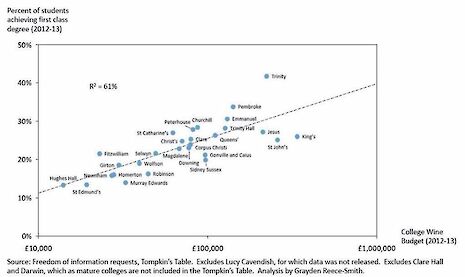A boozy correlation: wine expenditure and Firsts
Data compiled by a Cambridge graduate shows a correlation between colleges’ wine expenditures and Firsts

A graph produced by a Cambridge graduate demonstrates a striking correlation between the wine budgets of Cambridge colleges and the academic attainment of their students.
Kings, St John’s, Trinity and Jesus – the four colleges with an annual wine budget over £200,000 – all obtained more firsts than the collegiate average during the last academic year. With an annual wine expenditure of £14,033 and only 13.2% of students receiving first class degrees, Hughes Hall represents the lowest point on the graph.
King’s College is a notable outlier. Its £338,559 wine budget is the largest of any of the colleges, but it obtained markedly fewer first class degrees than some of its more frugal counterparts. The size of the college’s wine budget has already attracted negative publicity in the weeks since the college’s alcohol outlay was originally made public via a Freedom of Information request. The college’s Living Wage campaigners have adopted the slogan ‘Wages not Wine’ as the rallying cry for their protests.
Grayden Reece-Smith, a student at Churchill College from 2007 to 2010, decided to create the chart after noticing that the colleges with the highest wine budgets were also traditionally those ranked as the best academic performers by in the annual Tompkins Table.
Speaking to Varsity, Reece-Smith said he believed the graph reflected correlation rather than causation: “I do not believe that a high wine budget causes good grades.
“Colleges that are older, larger and wealthier tend to have higher wine budgets, in part because historically fellows have often been paid in food and wine. The same colleges also tend to perform well academically.”
He added that he did not find the college expenditure unreasonable, noting that the fellows’ wine consumption was not “frivolous expenditure” but rather “part of the pay package”.
The graphic has proved an instant hit on social media since Reece-Smith first posted it to Facebook yesterday. Some have taken the data as proof positive they should have spent less time in the library and more time in the pub, with Cambridge graduate @ThomMarriott tweeting: “I only got 2.1 #didnotdrinkenough”. However most seem to agree with the graph’s creator that it is simply a novel representation of the well-established connection between college assets and academic attainment.
Reece-Smith also points out that because the raw data only considers the alcohol expenditure as a ‘lump-sum’ amount per college, the picture lacks nuance. “There are various improvements to the analysis that could be done – looking at wine as a percentage of the budget or wine per student” he said, before adding “but I have better things to do with my life.”
 News / Churchill announces June Event in place of May Ball3 December 2025
News / Churchill announces June Event in place of May Ball3 December 2025 News / Cambridge cosies up to Reform UK30 November 2025
News / Cambridge cosies up to Reform UK30 November 2025 News / Cambridge Tennis Club students accused of ‘gleeful’ racist hate crime4 December 2025
News / Cambridge Tennis Club students accused of ‘gleeful’ racist hate crime4 December 2025 News / University Centre hangs in the balance28 November 2025
News / University Centre hangs in the balance28 November 2025 News / Write for Varsity this Lent3 December 2025
News / Write for Varsity this Lent3 December 2025








